Study on Multi-Objective Optimization of Power System Parameters of Battery Electric Vehicles
Abstract
1. Introduction
2. Numerical Method
2.1. Pure Electric Vehicle System Configuration
2.2. MATLAB Simulation Platform
2.3. Performance Constraints of Pure Electric Vehicles
2.3.1. Maximum Speed Constraints and Climbing Performance Constraints
2.3.2. Accelerated Performance Constraints
2.3.3. Constraint Condition
2.4. Parameter Optimization Method
2.5. Pareto Solution Set Solution Method
3. Results and Discussion
3.1. The Establishment of Optimization Indicators
3.2. Transmission Ratio and Gear Shift Logic
3.3. Determine the Feasible Domain of Transmission Ratio for Motor A and B
3.4. Solving for the Multi-Objective Genetic Algorithm
3.4.1. Motor A + Fixed Transmission Ratio Transmission
3.4.2. Motor A + 2-Gear Transmission
3.4.3. Motor B + Two-Gear Transmission
3.5. Determination of the Final Protocol
4. Test Verification
4.1. Verification of Dynamic Performance Index
4.2. Verification of Economic Indicators
5. Conclusions
Author Contributions
Funding
Institutional Review Board Statement
Informed Consent Statement
Data Availability Statement
Conflicts of Interest
References
- Zhang, Z.; Dong, R.; Tan, D.; Duan, L.; Jiang, F.; Yao, X.; Yang, D.; Hu, J.; Zhang, J.; Zhong, W.; et al. Effect of structural parameters on diesel particulate filter trapping performance of heavy-duty diesel engines based on gray correlation analysis. Energy 2023, 271, 127025. [Google Scholar] [CrossRef]
- Jiang, F.; Zhou, J.; Hu, J.; Tan, X.; Cao, W.; Tan, Z. Study on Performance of Locomotive Diesel Engine Fueled with Biodiesel Using Two Miller Cycle Technologies. Processes 2022, 10, 372. [Google Scholar] [CrossRef]
- Gao, C.; Na, H.; Song, K.; Xu, Q. Assessment of different methods in analyzing motor vehicle emission factors. Environ. Sci. Pollut. Res. Int. 2022, 29, 75441–75454. [Google Scholar] [CrossRef]
- Tan, D.; Meng, Y.; Tian, J.; Zhang, C.; Zhang, Z.; Yang, G.; Cui, S.; Hu, J.; Zhao, Z. Utilization of renewable and sustainable diesel/methanol/n-butanol (DMB) blends for reducing the engine emissions in a diesel engine with different pre-injection strategies. Energy 2023, 269, 126785. [Google Scholar] [CrossRef]
- Yeom, K. Model predictive control and deep reinforcement learning based energy efficient eco-driving for battery electric vehicles. Energy Rep. 2022, 8, 34–42. [Google Scholar] [CrossRef]
- Xiong, H.; Zhu, X.; Zhang, R. Energy recovery strategy numerical simulation for dual axle drive pure electric vehicle based on motor loss model and big data calculation. Complexity 2018, 10, 14–29. [Google Scholar] [CrossRef]
- Lu, M.; Zhang, X.; Ji, J.; Xu, X.; Zhang, Y. Research progress on power battery cooling technology for electric vehicles. J. Energy Storage 2020, 27, 101155. [Google Scholar] [CrossRef]
- Han, X.; Ouyang, M.; Lu, L.; Li, J. A comparative study of commercial lithium ion battery cycle life in electric vehicle: Capacity loss estimation. J. Power Sources 2014, 268, 658–669. [Google Scholar] [CrossRef]
- Gandoman, F.H.; Ahmadi, A.; Van den, B.P.; Mierlo, V.J.; Omar, N.; Nezhad, E.A.; Mavalizadeh, H.; Mayet, C. Status and future perspectives of reliability assessment for electric vehicles. Reliab. Eng. Syst. Saf. 2019, 183, 1–16. [Google Scholar] [CrossRef]
- Wang, Z.; Zhao, L.; Kong, Z.; Yu, J.; Yan, C. Development of accelerated reliability test cycle for electric drive system based on vehicle operating data. Eng. Fail. Anal. 2022, 141, 106696. [Google Scholar] [CrossRef]
- Guo, Y.; Wang, L.; Liao, C. Modeling and Analysis of Conducted Electromagnetic Interference in Electric Vehicle Power Supply System. Prog. Electromagn. Res. 2013, 139, 193–209. [Google Scholar] [CrossRef]
- Mustafa, U.; Ahmed, R.; Watson, A.; Wheeler, P.; Ahmed, N.; Dahele, P. A Comprehensive Review of Machine-Integrated Electric Vehicle Chargers. Energies 2022, 16, 129. [Google Scholar] [CrossRef]
- Venkata, G.; Kumar, M.; Goud, B.; Bajaj, M.; Abou, H.; Kamel, S. Design of a bidirectional DC/DC converter for a hybrid electric drive system with dual-battery storing energy. Front. Energy Res. 2022, 10, 1732. [Google Scholar]
- Andre, A.; Jose, A.; Giorgio, S.; Leonardo, A. Energy Management Fuzzy Logic Supervisory for Electric Vehicle Power Supplies System. IEEE Trans. Power Electron. 2008, 23, 107–115. [Google Scholar]
- Ahmad, A.; Khalid, M.; Ullah, Z.; Ahmad, N.; Aljaidi, M.; Malik, F.; Manzoor, U. Electric Vehicle Charging Modes, Technologies and Applications of Smart Charging. Energies 2022, 15, 9471. [Google Scholar] [CrossRef]
- Du, W.; Zhao, S.; Jin, L.; Gao, J.; Zheng, Z. Optimization design and performance comparison of different powertrains of electric vehicles. Mech. Mach. Theory 2021, 156, 104143. [Google Scholar] [CrossRef]
- Li, Z.; Khajepour, A.; Song, J. A comprehensive review of the key technologies for pure electric vehicles. Energy 2019, 182, 824–839. [Google Scholar] [CrossRef]
- Wang, W.; Liu, W.; Tao, B.; Ma, J. Parameter Design and Simulation Research of Power System for Electric Vehicle. Appl. Mech. Mater. 2014, 496, 969–973. [Google Scholar] [CrossRef]
- Wang, Z.; Zhou, J.; Rizzoni, G. A review of architectures and control strategies of dual-motor coupling powertrain systems for battery electric vehicles. Renew. Sustain. Energy Rev. 2022, 162, 112455. [Google Scholar] [CrossRef]
- Xu, L.; Ouyang, M.; Li, J.; Yang, F.; Lu, L.; Hua, J. Optimal sizing of plug-in fuel cell electric vehiclesusing models of vehicle performance and system cost. Appl. Energy 2013, 103, 477–487. [Google Scholar] [CrossRef]
- Murgovski, N.; Johannesson, L.; Sjöberg, J.; Egardt, B. Component sizing of a plug-in hybrid electric powertrain via convex optimization. Mechatronics 2012, 22, 106–120. [Google Scholar] [CrossRef]
- Zhang, M.; Wang, D.; Wang, M.; Yang, J. Several novel intelligent optimization algorithms for solving constrained engineering problems and their prospects. J. Comput. Appl. 2022, 42, 534–541. [Google Scholar]
- Omar, H.; Joeri, V.M. Optimal power management and powertrain components sizing of fuel cell/battery hybrid electric vehicles based on particle swarm optimisation. Veh. Des. 2012, 58, 200–222. [Google Scholar]
- Fu, X.; Zhang, Q.; Tang, J.; Wang, C. Parameter Matching Optimization of a Powertrain System of Hybrid Electric Vehicles Based on Multi-Objective Optimization. Electronics 2019, 8, 875. [Google Scholar] [CrossRef]
- Mo, T.; Li, Y.; Lau, K.; Poon, C.; Wu, Y.; Luo, Y. Trends and Emerging Technologies for the Development of Electric Vehicles. Energies 2022, 15, 6271. [Google Scholar] [CrossRef]
- Gao, J.; Wei, Y.; Liu, Z.; Qiao, H. Matching and Optimization for Powertrain System of Parallel Hybrid Electric Vehicle. Appl. Mech. Mater. 2013, 2516, 423–431. [Google Scholar] [CrossRef]
- Xue, Q.; Zhang, X.; Teng, T.; Yue, M. Dynamic coordinated control strategy of power on gear shifting for novel dual motor electric vehicle. Sustain. Energy Technol. Assess. 2023, 55, 102941. [Google Scholar] [CrossRef]
- Zhu, B.; Zhang, N.; Walker, P.; Zhou, X.; Zhan, W.; Wei, Y.; Ke, N. Gear shift schedule design for multi-speed pure electric vehicles. Proc. Inst. Mech. Eng. Part D J. Automob. Eng. 2015, 229, 70–82. [Google Scholar] [CrossRef]
- Roy, S.; Pandey, R. A Review on Motor and Drive System for Electric Vehicle. In Planning of Hybrid Renewable Energy Systems, Electric Vehicles and Microgrid: Modeling, Control and Optimization; Spring: Berlin/Heidelberg, Germany, 2022; pp. 601–628. [Google Scholar]
- Fichtner, M. Recent research and progress in batteries for electric vehicles. Batter. Supercaps 2022, 5, 202100224. [Google Scholar] [CrossRef]
- Husain, I. Electric and Hybrid Vehicles: Design Fundamentals; CRC Press: Boca Raton, FL, USA, 2021. [Google Scholar]
- El Hadraoui, H.; Zegrari, M.; Hammouch, F.E.; Guennouni, N.; Laayati, O.; Chebak, A. Design of a Customizable Test Bench of an Electric Vehicle Powertrain for Learning Purposes Using Model-Based System Engineering. Sustainability 2022, 14, 10923. [Google Scholar] [CrossRef]
- Mazali, I.; Daud, Z.; Hamid, M.; Tan, V.; Samin, P.; Jubair, A.; Ibrahim, K.; Kob, C.; Xinrui, W.; Talib, M. Review of the methods to optimize power flow in electric vehicle powertrains for efficiency and driving performance. Appl. Sci. 2022, 12, 1735. [Google Scholar] [CrossRef]
- Geng, J.; Chi, Q. Parameter matching and simulation analysis of power system of pure electric vehicle. In Journal of Physics: Conference Series; IOP Publishing: Bristol, UK, 2021; Volume 2076, p. 012091. [Google Scholar]
- Maheshwari, A.; Nageswari, S. Real-time state of charge estimation for electric vehicle power batteries using optimized filter. Energy 2022, 254, 124328. [Google Scholar] [CrossRef]
- Rousseau, A.; Pagerit, S.; Gao, W. Plug-In Hybrid Electric Vehicle Control Strategy Parameter Optimization. J. Asian Electr. Veh. 2008, 6, 1125–1133. [Google Scholar] [CrossRef]
- Zhu, K.; Li, T.; Qin, S.; Xu, G.; Fang, L. Simultaneous Optimization for Hybrid Electric Vehicle Parameters Based on Multi-Objective Genetic Algorithms. Energies 2011, 4, 532–544. [Google Scholar]
- Nguyen, C.; Nguyễn, B.; Trovao, J.; Ta, M. Optimal drivetrain design methodology for enhancing dynamic and energy performances of dual-motor electric vehicles. Energy Convers. Manag. 2022, 252, 115054. [Google Scholar] [CrossRef]
- GB/T 28382—2012; The National Technical Committee on Automobile Standardization. Technical Conditions of Pure Electric Passenger Vehicles. China Standards Press: Beijing, China, 2012.
- Foster, S.N. Condition Monitoring Accuracy in Inverter-Driven Permanent Magnet Synchronous Machines Based on Motor Voltage Signature Analysis. Energies 2023, 16, 1477. [Google Scholar]
- Boris, J.; Paolo, L.; Guido, M. Control of double-loop permanent magnet synchronous motor drives by optimized fractional and distributed-order PID controllers. Eur. J. Control 2020, 58, 232–244. [Google Scholar]
- Wang, S.; Hui, Y.; Sun, X.; Shi, D. Neural network sliding mode control of intelligent vehicle longitudinal dynamics. IEEE Access 2019, 7, 162333–162342. [Google Scholar] [CrossRef]
- Thomas, G. Fundamentals of Vehicle Dynamics; SAE International: Pittsburgh, PA, USA, 2021. [Google Scholar]
- GB/T 18385—2005; The National Technical Committee on Automobile Standardization. Test Method of Electric Vehicle. China Standards Press: Beijing, China, 2005.
- Indranil, D.; Kumar, R. A genetic algorithm based heuristic optimization technique for solving balanced allocation problem involving overall shipping cost minimization with restriction to the number of serving units as well as customer hubs. Results Control. Optim. 2023, 11, 100227. [Google Scholar]
- Lu, T.; Lu, Z.; Gao, Y.; Shi, L.; Wang, H.; Wang, T. Investigation on suitable swirl ratio and spray angle of a large-bore marine diesel engine using genetic algorithm. Fuel 2023, 345, 128187. [Google Scholar] [CrossRef]
- Xie, F.; Sun, Q.; Zhao, Y.; Du, H. An Improved Directed Crossover Genetic Algorithm Based on Multilayer Mutation. J. Control. Sci. Eng. 2022, 2022, 4398952. [Google Scholar] [CrossRef]
- John, P.; Vlad, S.; Hines, W. Neural Network Acceleration of Genetic Algorithms for the Optimization of a Coupled Fast/Thermal Nuclear Experiment. Front. Energy Res. 2022, 10, 874194. [Google Scholar]
- Antipina, E.; Mustafina, S.; Antipin, A. Algorithm of Solving a Multiobjective Optimization Problem on the Basis of a Kinetic Chemical Reaction Model. Optoelectron. Instrum. Data Process. 2022, 57, 668–674. [Google Scholar] [CrossRef]
- Brito, B.; Antónia, M.; Fernando, J. A diversity-based genetic algorithm for scenario generation. Eur. J. Oper. Res. 2022, 299, 1128–1141. [Google Scholar]
- Deb, K. Multi-objective optimization. In Search Methodologies; Springer: New Yore, NY, USA, 2014; pp. 403–449. [Google Scholar]
- Marler, R.; Arora, J. Survey of multi-objective optimization methods for engineering. Struct. Multidiscip. Optim. 2004, 26, 369–395. [Google Scholar] [CrossRef]
- Cao, J.; Yan, Z.; Chen, Z.; Zhang, J. A Pareto front estimation-based constrained multi-objective evolutionary algorithm. Appl. Intell. 2022, 1–37. [Google Scholar] [CrossRef]
- Xu, Y.; Zhang, H.; Huang, L.; Qu, R.; Nojima, Y. A Pareto Front Grid Guided Multi-Objective Evolutionary Algorithm. Appl. Soft Comput. 2023, 136, 110095. [Google Scholar] [CrossRef]
- Zhang, C.; Gao, L.; Li, X.; Shen, W.; Zhou, J.; Tan, K. Resetting Weight Vectors in MOEA/D for Multiobjective Optimization Problems with Discontinuous Pareto Front. IEEE Trans. Cybern. 2021, 59, 9770–9783. [Google Scholar] [CrossRef]
- Sato, H. Inverted PBI in MOEA/D and its impact on the search performance on multi and many-objective optimization. Genet. Evol. Comput. 2014, 645–652. [Google Scholar]
- Liang, J.; Qiao, K.; Yu, K.; Qu, B.; Yue, C.; Guo, W.; Wang, L. Utilizing the Relationship between Unconstrained and Constrained Pareto Fronts for Constrained Multiobjective Optimization. IEEE Trans. Cybern. 2022. [Google Scholar] [CrossRef]
- Jiang, F.; Cao, W.; Tan, X.; Hu, J.; Zhou, J.; Tan, Z. Optimization Analysis of Locomotive Diesel Engine Intake System Based on Matlab-Simulink and GT-Power. Processes 2022, 10, 157. [Google Scholar] [CrossRef]
- Jiang, F.; Zhou, J.; Hu, J.; Tan, X.; Mo, Q.; Cao, W. Performance Comparison and Optimization of 16V265H Diesel Engine Fueled with Biodiesel Based on Miller Cycle. Processes 2022, 10, 1412. [Google Scholar] [CrossRef]
- Tan, D.; Wu, Y.; Lv, J.; Li, J.; Ou, X.; Meng, Y.; Lan, G.; Chen, Y.; Zhang, Z. Performance optimization of a diesel engine fueled with hydrogen/biodiesel with water addition based on the response surface methodology. Energy 2023, 263, 125869. [Google Scholar] [CrossRef]
- Zhang, Z.; Dong, R.; Lan, G.; Yuan, T.; Tan, D. Diesel particulate filter regeneration mechanism of modern automobile engines and methods of reducing PM emissions: A review. Environ. Sci. Pollut. Res. 2023, 30, 39338–39376. [Google Scholar] [CrossRef] [PubMed]
- Zhang, Z.; Li, J.; Tian, J.; Dong, R.; Zou, Z.; Gao, S.; Tan, D. Performance, combustion and emission characteristics investigations on a diesel engine fueled with diesel/ethanol/n-butanol blends. Energy 2022, 249, 123733. [Google Scholar] [CrossRef]

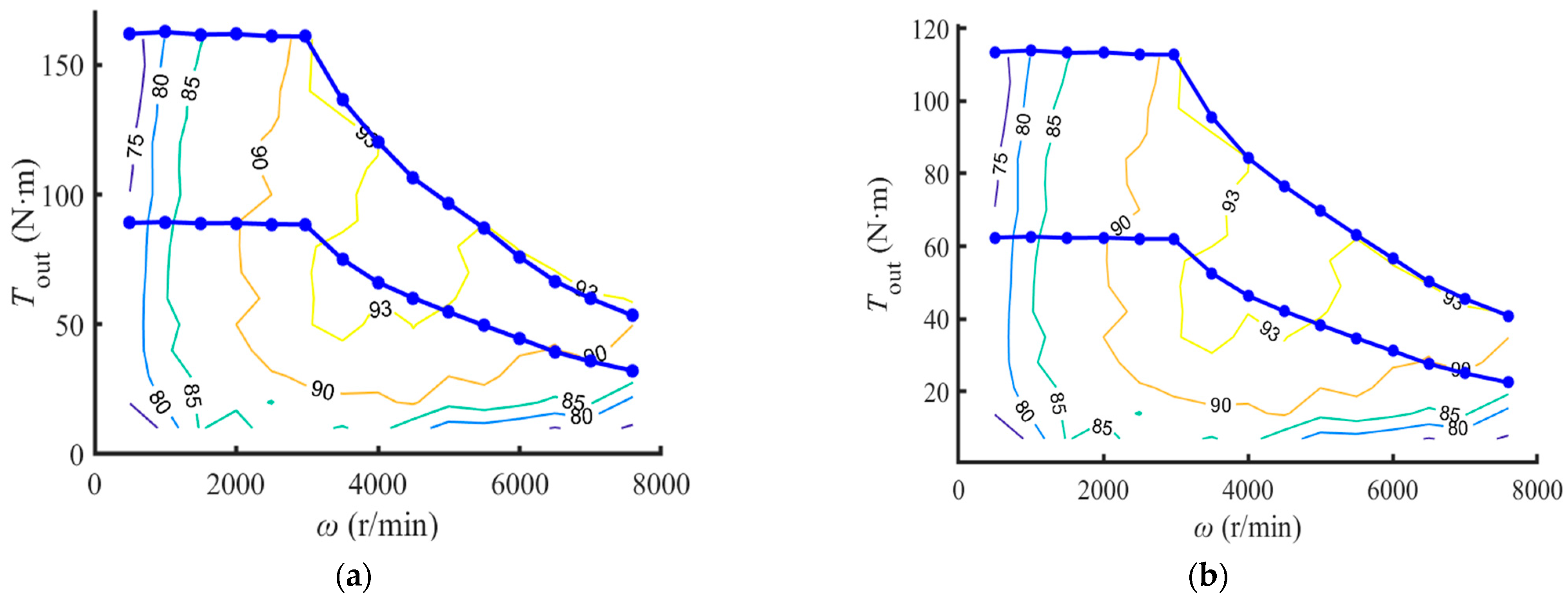
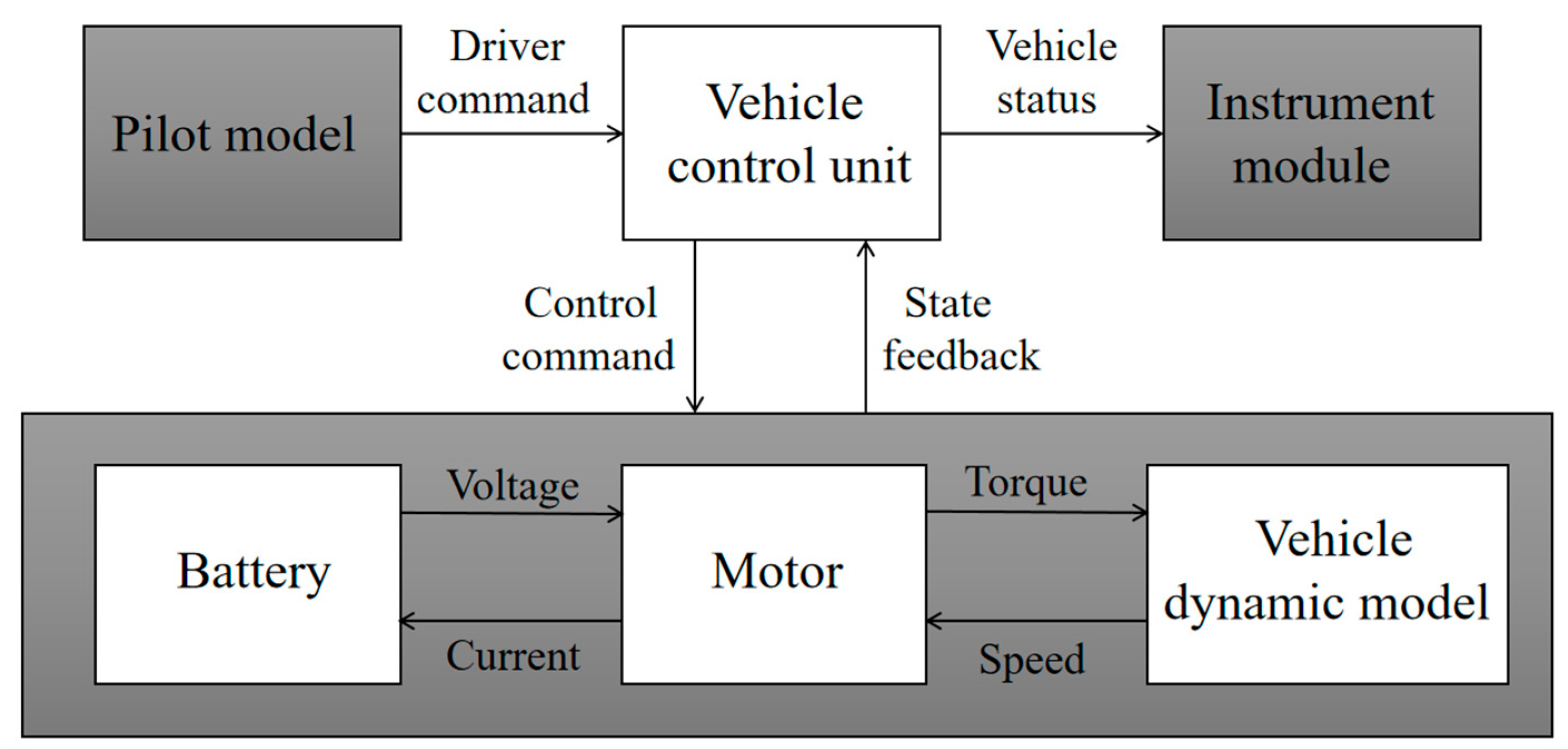
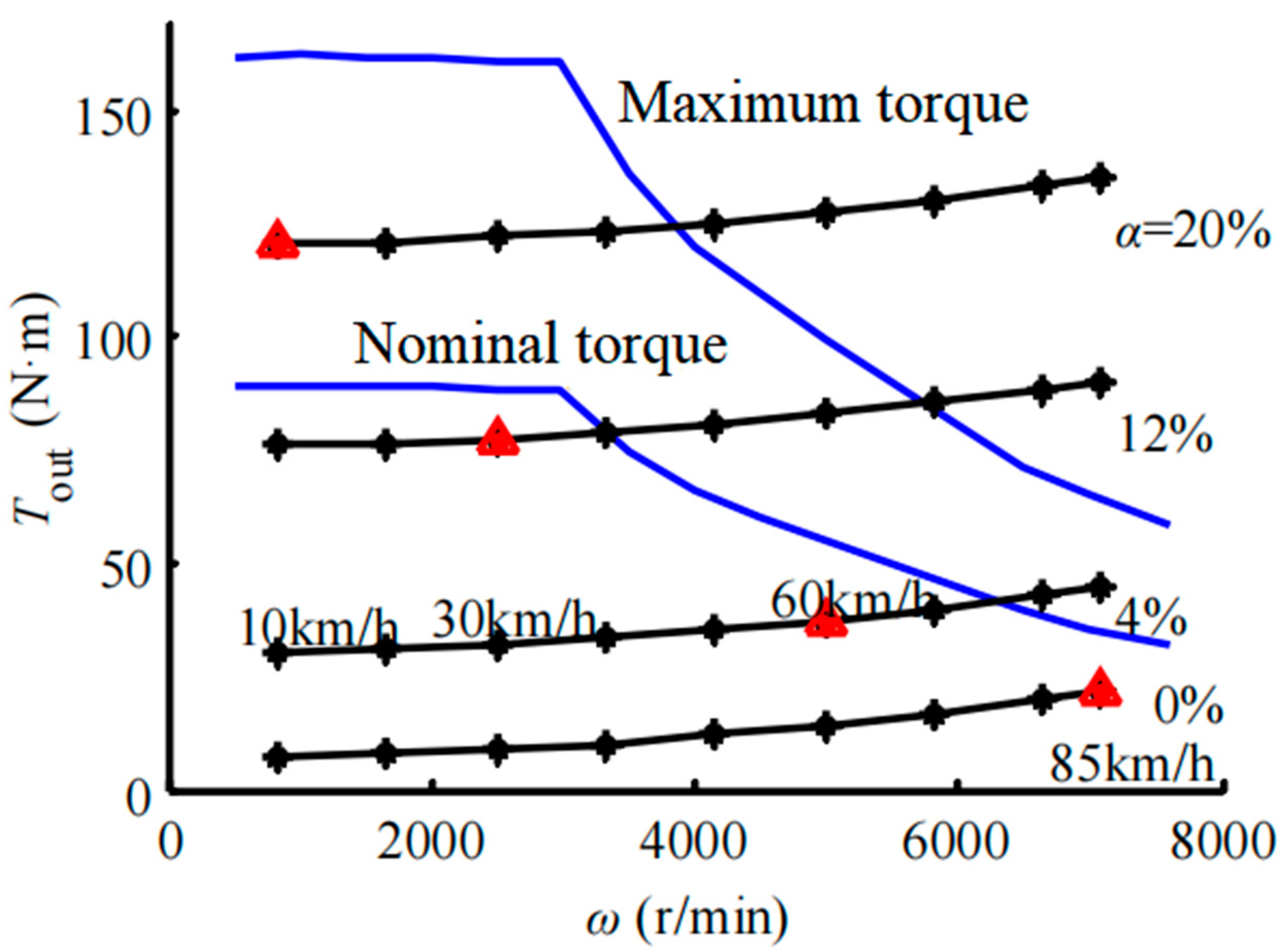
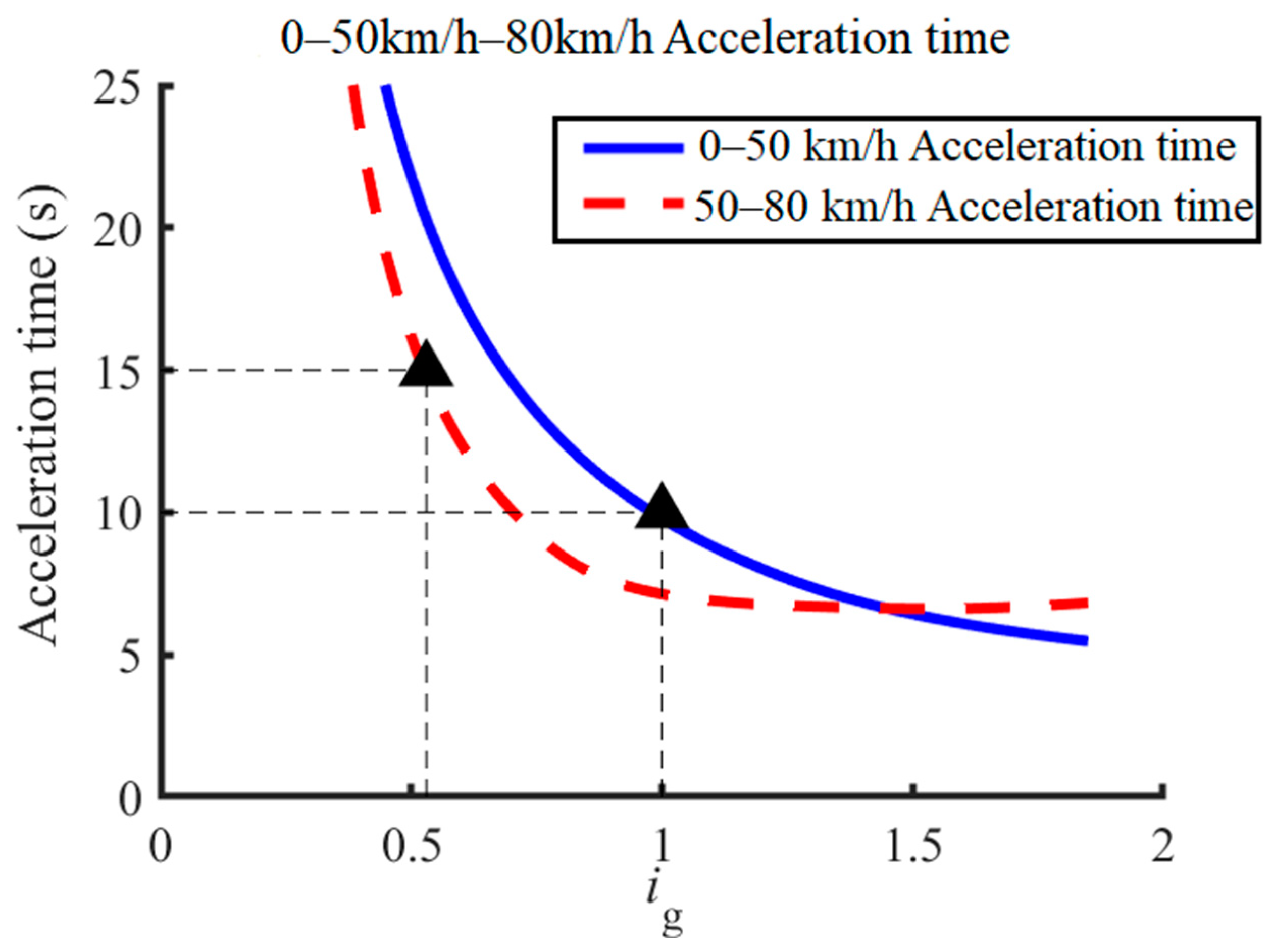

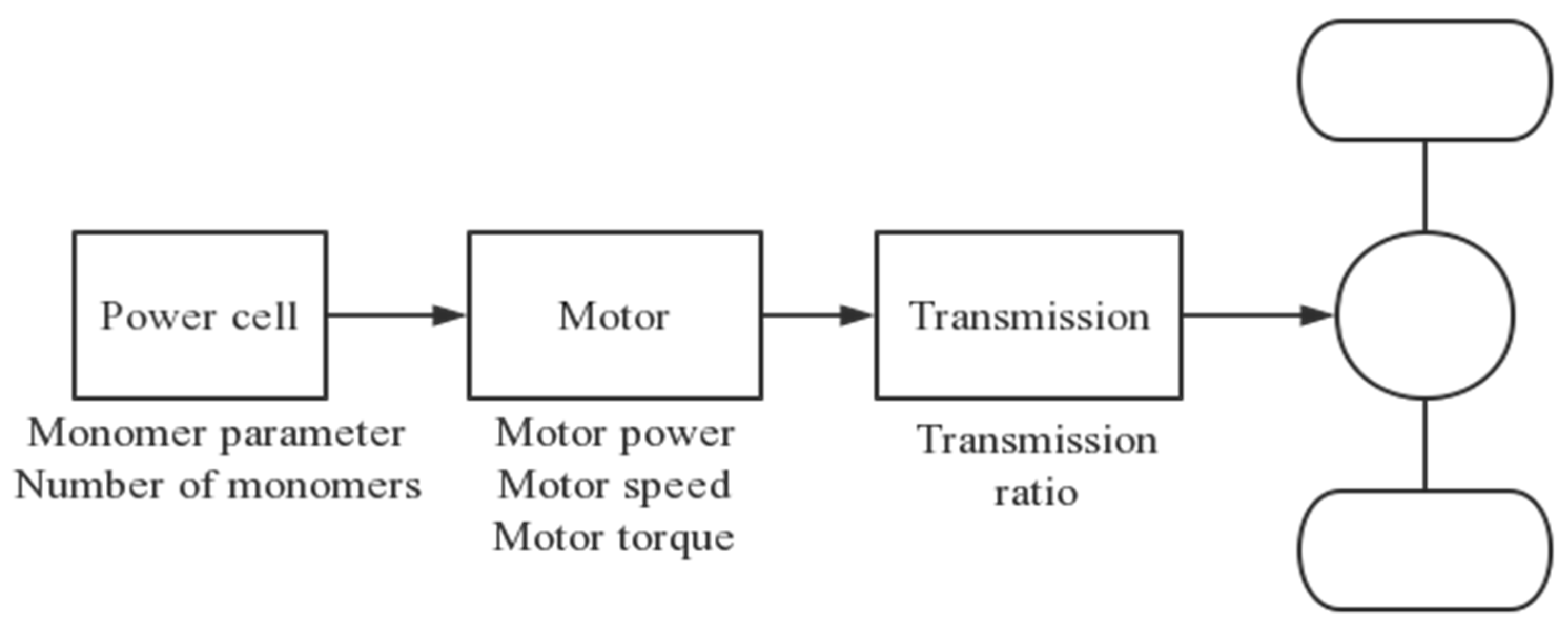
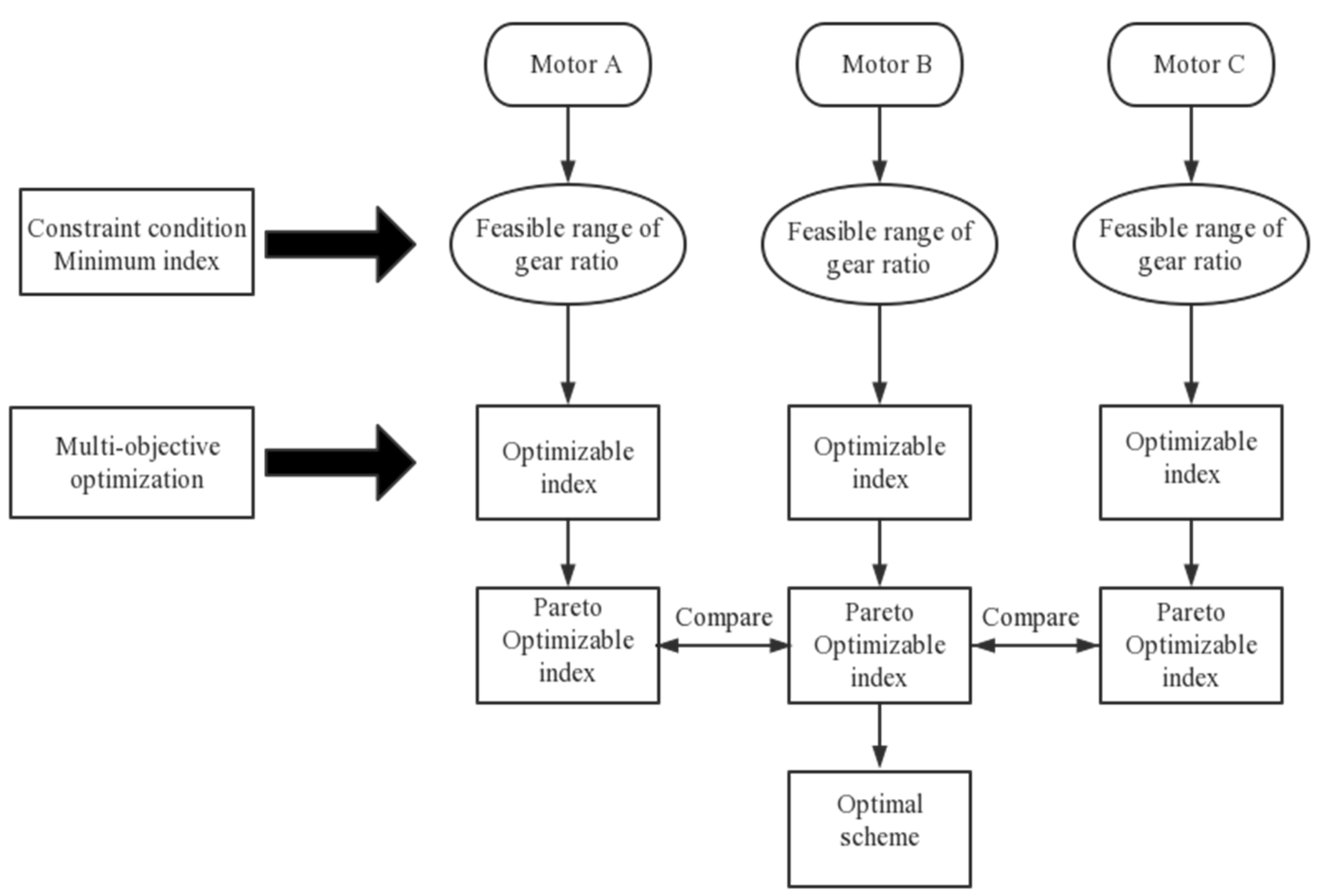

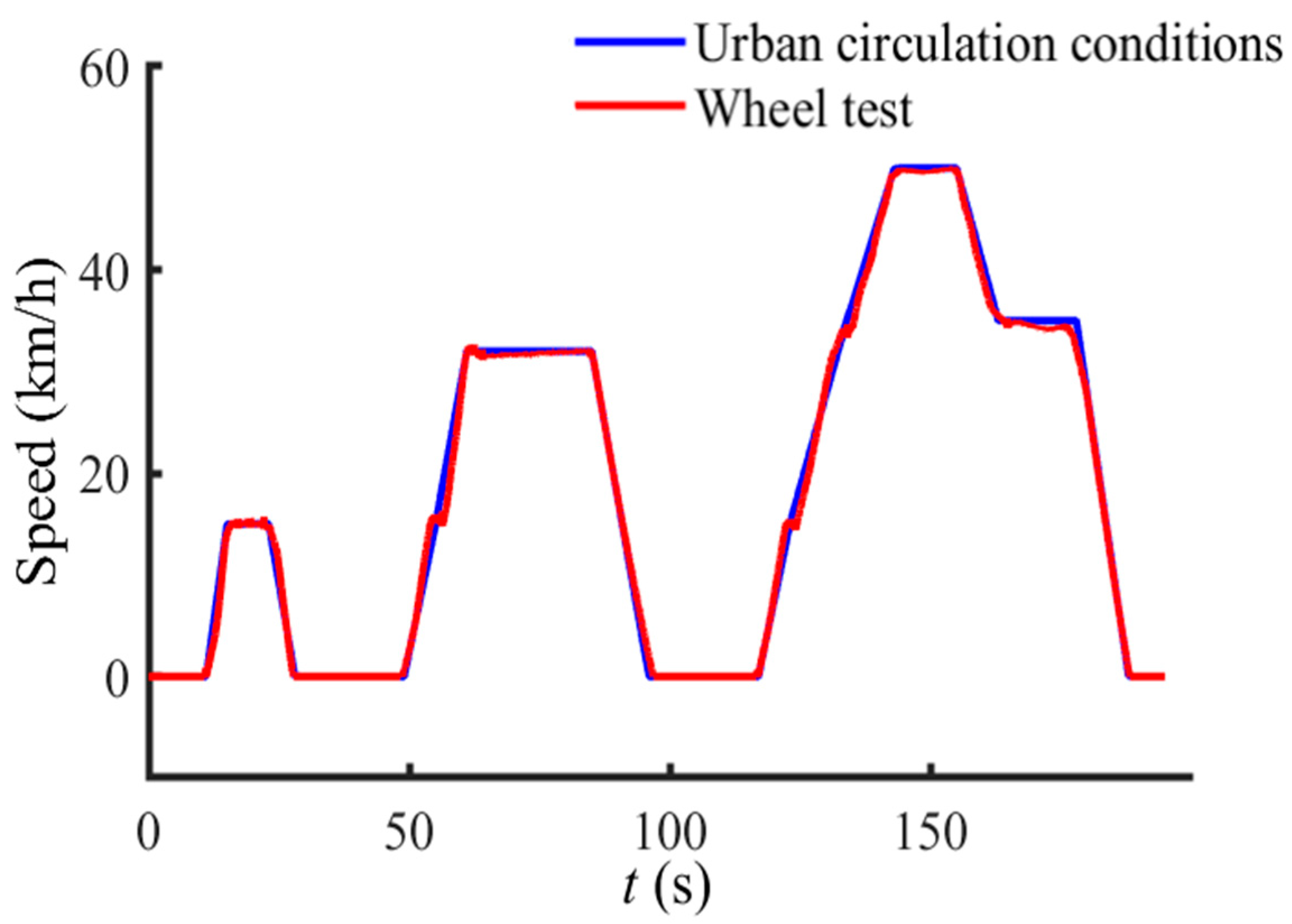
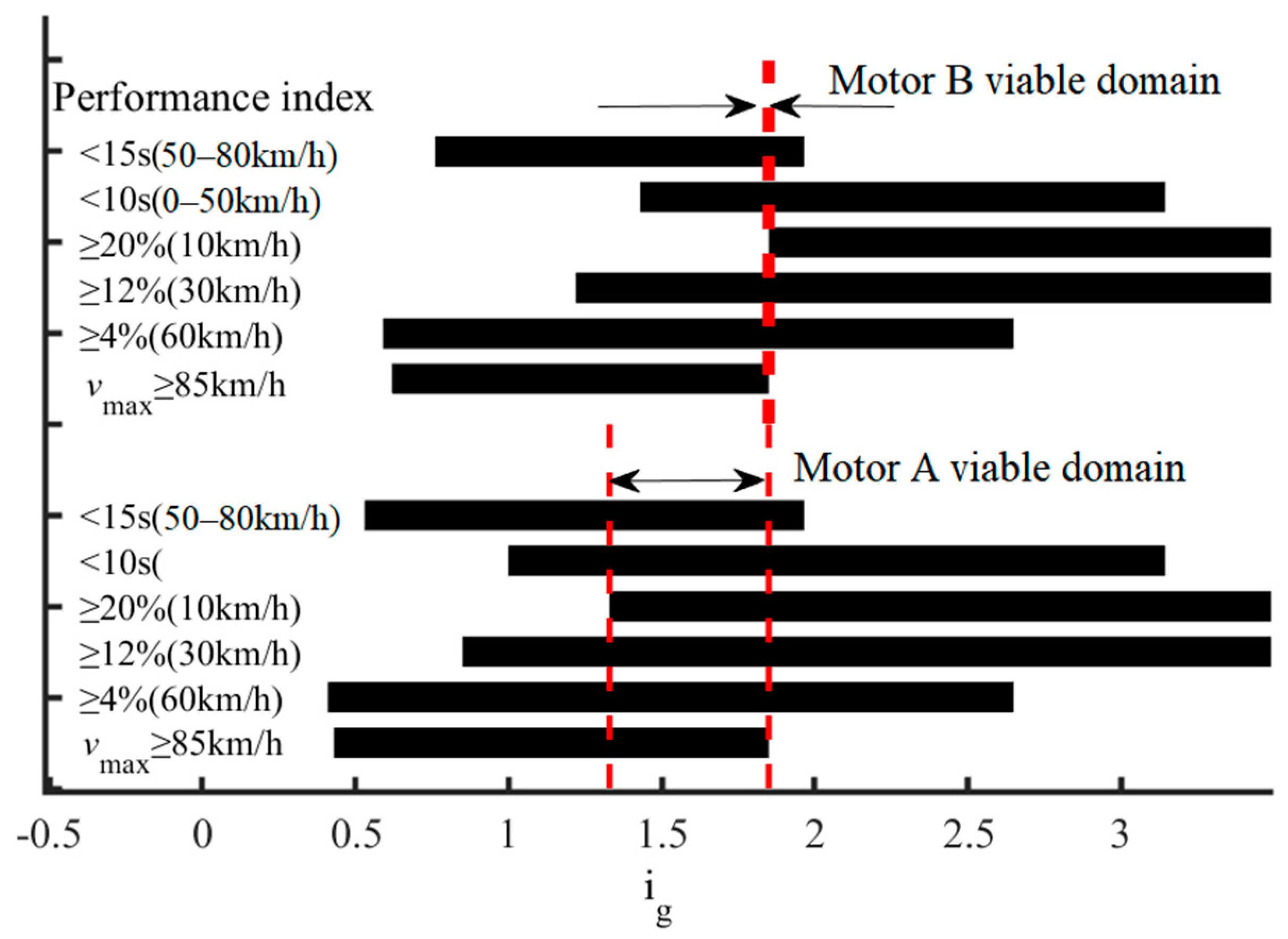
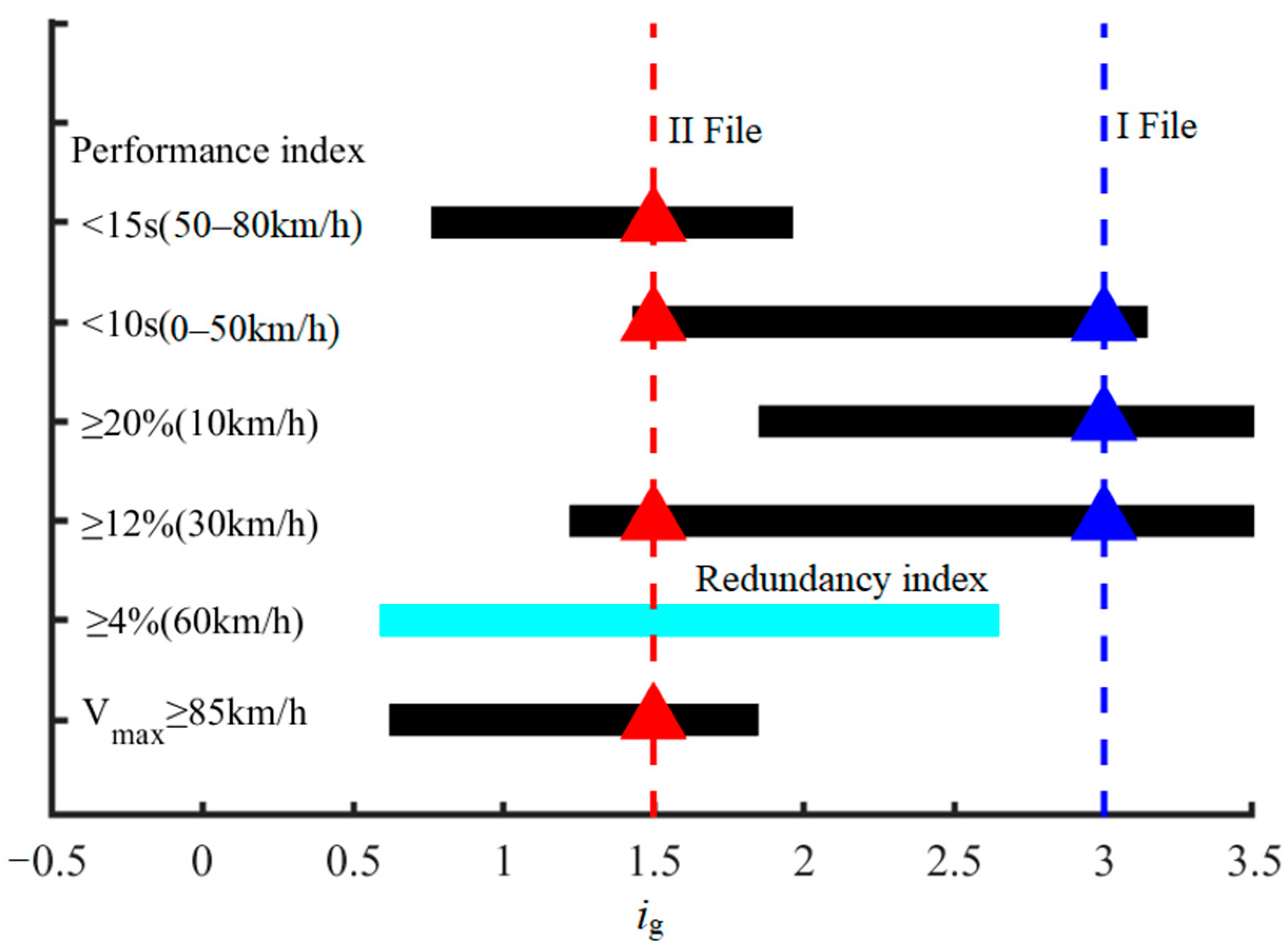




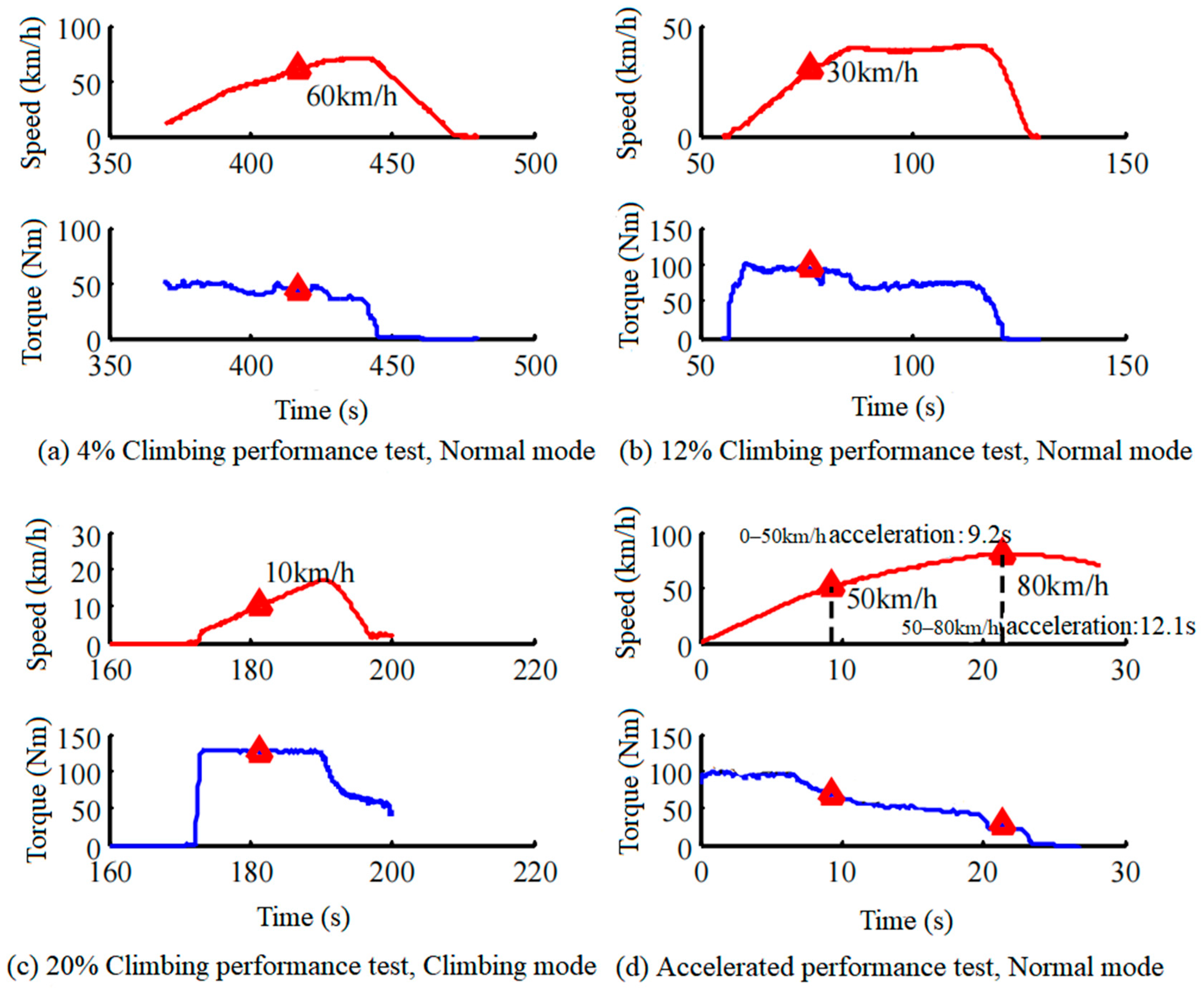

| The Parameter Name | Numerical Value |
|---|---|
| Curb weight mv (kg) | 1455 |
| Main deceleration ratio i0 | 4.889 |
| Additional quality of the test mcap (kg) | 180 |
| Rolling resistance coefficient ƒ | 0.012 |
| Wheel base l (mm) | 2490 |
| Transmission efficiency ηT | 0.93 |
| Rolling radius Rw (m) | 0.273 |
| Front/rear axis charge ratio (%) | 36/64 |
| Height of center of mass hg (mm) | 510 |
| Front face area Aveh (m2) | 2.593 |
| Air resistance coefficient CD | 0.456 |
| The transmission system is used to rotation IT (kg·m2) | 0.0335 |
| Wheel rotation inertia Iw (kg·m2) | 0.4 |
| Motor rotation inertia Imot (kg·m2) | 0.0335 |
| Sequence Number | Vehicle Performance Indicators | GB/28382 | Design Value |
|---|---|---|---|
| 1 | Maximum speed | ≥80 km/h (30 min) | ≥85 km/h (30 min) |
| 2 | Climbing performance I | ≥4% (60 km) | ≥4% (60 km) |
| 3 | Climbing performance II | ≥12% (30 km) | ≥12% (30 km) |
| 4 | Climbing performance III | ≥20% | ≥20% (10 km/h) |
| 5 | Accelerating ability I | 0–50 km/h < 10 s | 0–50 km/h < 10 s |
| 6 | Accelerating ability II | 50–80 km/h < 15 s | 50–80 km/h < 15 s |
| 7 | Endurance mileage | ≥80 km | ≥80 km |
| 8 | Hundreds of kilometers of electricity consumption | Unspecified | Unspecified |
| Sequence Number | Performance Index Name | Performance Index Setting Counting | Transmission Ratio Viable Domain (Motor A) | Transmission Ratio Viable Domain (Motor B) |
|---|---|---|---|---|
| 1 | Maximum speed | ≥85 km/h (30 min) | S1 = [0.43, 1.85] | S1 = [0.62, 1.85] |
| 2 | Climbing performance | ≥4% (60 km) | S2 = [0.41, 2.65] | S2 = [0.59, 2.65] |
| 3 | Climbing performance | ≥12% (30 km) | S3 = [0.85, 5.3] | S3 = [0.85, 5.3] |
| 4 | Climbing performance | ≥20% (10 km/h) | S4 = [1.33, 16] | S4 = [1.85, 16] |
| 5 | Accelerating ability | 0–50 km/h < 10 s | S5 = [1.0, 3.145] * | S5 = [1.0, 3.145] * |
| 6 | Accelerating ability | 50–80 km/h < 15 s | S6 = [0.53, 1.97] * | S6 = [0.53, 1.97] * |
| - | occur simultaneously | - | S = [1.33, 1.85] | S = [1.85, 1.85] |
| Algorithm Parameters | Scenario 1 | Scenario 2 | Scenario 3 |
|---|---|---|---|
| Population size | 100 | 300 | 300 |
| Maximum algebra | 100 | 200 | 200 |
| Number of variables | 1 | 2 | 2 |
| Selective rule | Tournament | Tournament | Tournament |
| Mutation function | Adaptive feasible | Adaptive feasible | Adaptive feasible |
| Cross rules | Intermediate | Intermediate | Intermediate |
| Cross probability | 100% | 100% | 100% |
| Pareto front Scale | 35% | 35% | 35% |
| Stall Generation | 20 | 30 | 30 |
| Function Tolerance | 0.0001 | 0.0001 | 0.0001 |
| Scenario | Preferred Scheme | Maximum Speed Vmax (km/h) | Accelerating Ability T0→50 (S) | Hundreds of Kilometers of Electricity Consumption E100kw (kW·h) | Pareto Optimal Solution ig* |
|---|---|---|---|---|---|
| Scenario 1 | 1a | 116 | 6.85 | 15.51 | 1.33 |
| 1b | 96 | 5.81 | 15.23 | 1.72 | |
| 1c | 88 | 5.48 | 15.32 | 1.85 | |
| Scenario 2 | 2a | 136 | 5.80 | 15.23 | [1.72, 0.98] |
| 2b | 136 | 4.39 | 15.81 | [2.99, 1.00] | |
| 2c | 104 | 4.47 | 15.29 | [2.81, 1.57] | |
| Scenario 3 | 3a | 116 | 6.41 | 15.51 | [2.99, 1.40] |
| 3b | 104 | 6.41 | 15.29 | [2.99, 1.57] |
| Performance Indicators to Be Optimized | The Lowest Index | Simulation Value | Tumbler Test |
|---|---|---|---|
| Maximum speed vmax (kW/h) | 85 | 88.42 | 87.35 |
| 0–50 kw/h Acceleration time T0→50 (S) | 10 | 9.4 | 9.2 |
| 50–80 kw/h Acceleration time T50→80 (S) | 15 | 12.6 | 12.1 |
| Hundreds of kilometers of electricity consumption E100kw (kW·h) | It is not stipulated | 15.26 | 15.39 |
| Endurance mileage (kW) | 100 | 108.3 | 107.2 |
| 60 kw/h hill climbing | >4% | >4% | >4% |
| 30 kw/h hill climbing | >12% | >12% | >12% |
| 10 kw/h hill climbing | >20% | >12% | >12% |
Disclaimer/Publisher’s Note: The statements, opinions and data contained in all publications are solely those of the individual author(s) and contributor(s) and not of MDPI and/or the editor(s). MDPI and/or the editor(s) disclaim responsibility for any injury to people or property resulting from any ideas, methods, instructions or products referred to in the content. |
© 2023 by the authors. Licensee MDPI, Basel, Switzerland. This article is an open access article distributed under the terms and conditions of the Creative Commons Attribution (CC BY) license (https://creativecommons.org/licenses/by/4.0/).
Share and Cite
Hu, J.; Cao, W.; Jiang, F.; Hu, L.; Chen, Q.; Zheng, W.; Zhou, J. Study on Multi-Objective Optimization of Power System Parameters of Battery Electric Vehicles. Sustainability 2023, 15, 8219. https://doi.org/10.3390/su15108219
Hu J, Cao W, Jiang F, Hu L, Chen Q, Zheng W, Zhou J. Study on Multi-Objective Optimization of Power System Parameters of Battery Electric Vehicles. Sustainability. 2023; 15(10):8219. https://doi.org/10.3390/su15108219
Chicago/Turabian StyleHu, Jie, Wentong Cao, Feng Jiang, Lingling Hu, Qian Chen, Weiguang Zheng, and Junming Zhou. 2023. "Study on Multi-Objective Optimization of Power System Parameters of Battery Electric Vehicles" Sustainability 15, no. 10: 8219. https://doi.org/10.3390/su15108219
APA StyleHu, J., Cao, W., Jiang, F., Hu, L., Chen, Q., Zheng, W., & Zhou, J. (2023). Study on Multi-Objective Optimization of Power System Parameters of Battery Electric Vehicles. Sustainability, 15(10), 8219. https://doi.org/10.3390/su15108219






